When we first meet Offred in Margaret Atwood’s The Handmaid’s Tale, she is thisclose to giving up. She’s losing track of time and, worse, hope; she vacillates between the equal temptations of escaping through suicide and just putting her head down and giving in to the system. She had a name, but it’s forbidden now, so she won’t even tell it to us.
By contrast, in Volker Schlöndorff’s 1990 film adaptation, our introduction to Kate—the name she’s given in Harold Pinter’s heavily streamlined screenplay—is watching her husband gunned down right in front of her at the Gilead/Canadian border before she’s dragged away with the rest of the fertile women. The entirety of the film is condensed into just a few months, as we watch Kate become a Handmaid, instead of the years in which life as a Handmaid is already her reality.
Book Offred’s trauma is lived-in. Movie Offred is still in shock. In short, there are absolutely no stakes.
In a parallel universe, there is a movie version of The Handmaid’s Tale starring Sigourney Weaver, fresh off Alien and Ghostbusters, her curly hair obscured by her red veil as she intones “Nolite te bastardes carborundorum” and plots the demise of her masters through a running interior monologue. But Weaver dropped out of the project because (irony of ironies!) she was pregnant, and Natasha Richardson stepped in to an adaptation where the screenwriter “had something specific against voice-overs” (as the actress later bemoaned) and the director thought this was an erotic thriller.
No, really. As The Atlantic tells it, Schlöndorff, coming from the New German Cinema movement, interpreted Atwood’s dystopian tale as “a thriller—a sexually charged and vivid drama without the nuance or emotional depth of the source material.” And so, bafflingly, the posters featured Natasha Richardson clutching her red Handmaid garb to her bare breasts, looking haunted, while Dunaway and Duvall loom over her. “This looks like a movie about a threesome gone wrong!” I said to my partner, laughing, to which he immediately replied, “Isn’t it?”
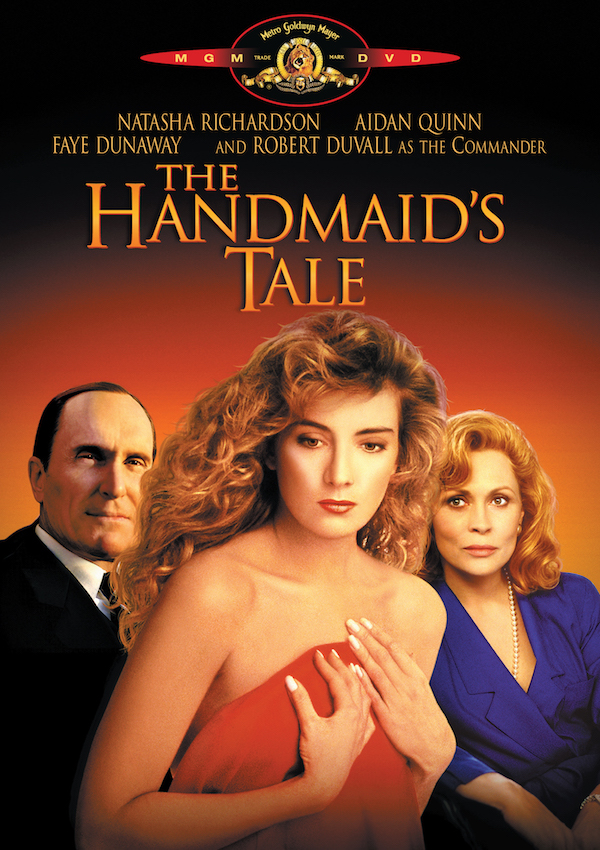
Unfortunately, Richardson’s onscreen persona reflects the passive woman in the print materials, and her delivery is all off. Due in part to what the New York Times described as the British actress’ “flat, toneless American accent but [enlivened] with her throaty purr,” Richardson’s Offred mostly seems bemused at her circumstances, never actually anguished.
But she’s also working with what she’s given, which in truth isn’t much. In adapting the novel, Pinter stripped away the many layers, side plots, and relationships that made Atwood’s story so rich. Luke is dead, his fate sealed rather than left as an uncertainty to haunt Offred later. Moira is not her friend from the pre-Gilead era, but simply another woman she encounters at the Red Center; their history is constrained to just a short time, and the intensity of their bond makes little sense. The Commander’s household, instead of her last chance, is her first posting. Offred has barely accepted what it means to be a Handmaid before all hell breaks loose with Mayday; the rest of the film’s events would mean little to her, let alone to audiences who likely had not read the book.
To add insult to injury, Pinter ditched any sort of internal monologue for Offred, not even a brief narration during the opening and closing credits to bookend the story. What you see is what you get—and considering that the Handmaids are punished for speaking out of turn and can’t even communicate with one another outside of coded pleasantries, losing the insight into Offred’s true thoughts makes it seem as if she doesn’t have much to contribute to her own story.
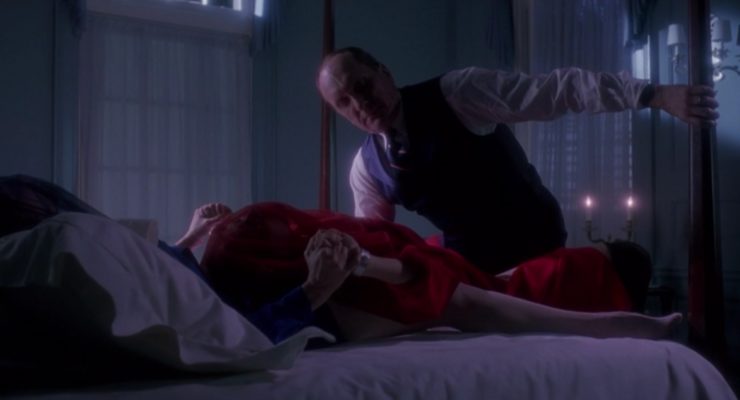
As a result, Offred’s character is defined by her actions, which are so over-the-top as to seem performative, disingenuous. After suffering through her first Ceremony as a Handmaid, Offred runs to her room, rips off her red gown, and throws open the window, baring her breasts to the outside as she sobs brokenheartedly. It’s such an incongruously eroticized shot, seeing as it takes place (a) in a dystopian thriller and (b) after a violent, agency-robbing rape. Then the moment, if that’s what it is, is broken: Nick (a smoldering Aidan Quinn) spots her from across the courtyard and seems less shocked by her nakedness than worried she’ll get caught; he half-scolds/half-warns her to cover up before she gets herself shot.
If Pinter and Schlöndorff were trying to make it clear how unsexy the life of a Handmaid is, they certainly succeeded. But Atwood already did that just in her description of the Ceremony. We didn’t need the additional histrionics, but I suspect that they were “required” to hammer home the extent of her anguish. All nonverbally, of course.
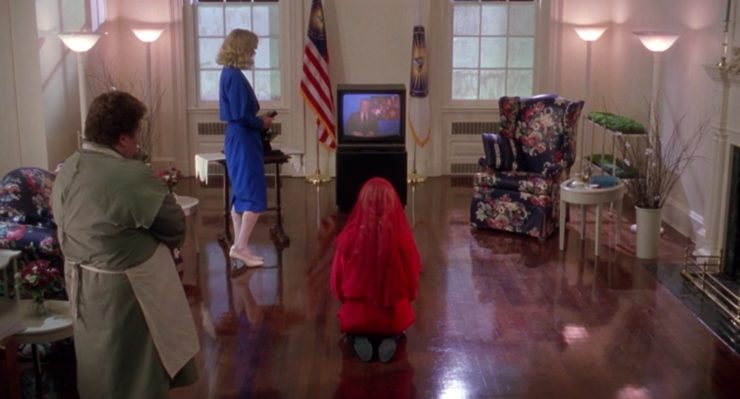
Similarly, the narrative structure foregoes any sort of layering in favor of the simplest and most straightforward timeline. The film proceeds in a completely linear fashion, no flashbacks or time jumps: Kate is captured at the border; Kate is conditioned at the Red Center; Kate is brought to the Commander’s household and renamed Offred. Events that are revealed later in the book, like the flashback to Moira’s escape, happen at approximately the same point in the movie but as part of the linear narrative. Therefore, the plot must contrive to take Kate out of the Commander’s household for a sleepover at the Red Center after her doctor’s appointment—despite it being a frequent, noninvasive procedure—so that she can be reunited with Moira and be the cattle prod-wielding assistant in her jailbreak. (And in that case, why not throw her Handmaid dress back on and slip out with her?)
For a story rich with symbolism, there are few motifs; the rare recurring visual—of her lost daughter Jill wandering through the snow calling out “Mommy?”—serves no real purpose to the story. The dystopian trappings are there in their technicolor brightness, and some visual choices—like having the Handmaids pull the rope to physically string up one of their own at the Women’s Salvaging, and Moira’s “sexy Handmaid” outfit at Jezebel’s—are excellent interpretations. Yet without any deeper insights, it’s all we have to go on.
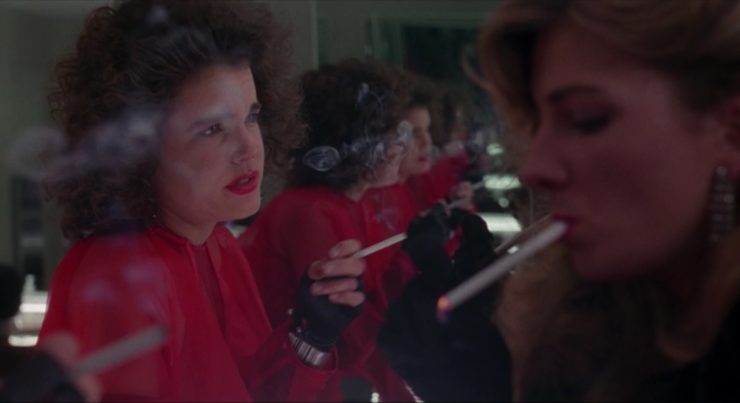
One of the biggest casualties in this streamlining is losing the moment in the past where everything changed: the malfunctioning debit cards, the mass layoffs, women downgraded to second-class citizens with the punch of a button. Offred’s imprisonment has barely begun, yet simultaneously she’s apparently been doing this forever. She makes a mention at Jezebel’s how she hasn’t had a drink in years, yet she’s been an official Handmaid for less than six months. So, did she spend at least a year training at the Red Center? Seems unlikely, as the Gileadeans were desperate to get Handmaids into households. Did Gilead extend its control slowly, outlawing vices like alcohol for years before they worked up to shooting potential escapees at the border? We have absolutely no idea because there is no story before or after these 109 minutes.
This is the problem with forcing a story to go from point A to B when the source material jumps around the whole damn alphabet (but does it damn well). Rather than resort to large infodumps, Atwood deliberately reveals only as many details as you need to know in any particular moment. So even though we learn this out of order, we can track the history of Gilead: first women lost their jobs and debit cards, then the Constitution got suspended, and so on and so forth—every terrifying micro and macro event leading up to Offred and Luke’s terrifying run to the border. Even as the story unfolds nonlinearly, Atwood still manages to keep the timeline, and worldbuilding, coherent.
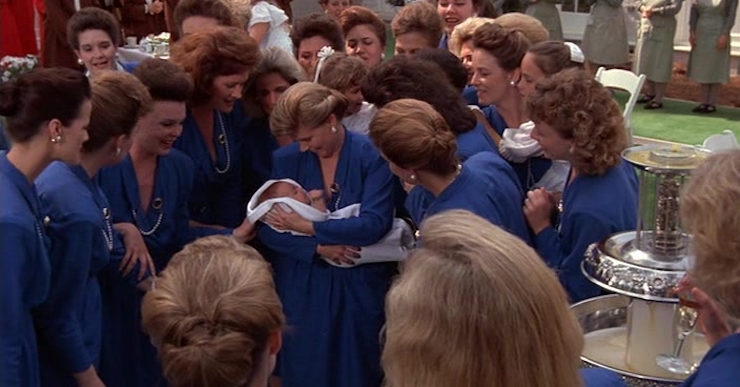
Oddly enough, we trade Offred’s interiority for more time with Serena Joy (Faye Dunaway) and the Commander (Robert Duvall). While in the novel they are only together when Offred is present, during the Ceremony, in the film we get at least two short scenes of them alone as a couple. While Offred is off walking with Ofglen, Fred pauses by the flower beds to comment on Serena’s commitment to her projects but really to ask about how she thinks Offred is fitting in to the household. Yet he claims that it’s all for her sake: “I want you to be happy, Serena.”
“Yes,” she retorts, not pausing in her planting, “life is so much easier for you when I am.” It’s a shocking dissent, as the Wives, for all their privilege, are still expected to be subservient to their husbands, but it’s also undercut with the sort of wry affection that comes from decades of marriage.

Later, when Serena and Offred are engaging in some “girl talk” about how soon they can both fulfill their duties by getting Offred knocked up, Serena’s comment “because a baby would make my life whole” carries a mocking edge. Faye Dunaway is far and away the best part of this film, as a Wife struggling to retain her dignity not only against the intrusion of a Handmaid but also in mourning for the life that had to be sacrificed to create Gilead’s social structures. For all that Richardson plays Offred’s horror at being raped during the Ceremony, there is a comparable expression of violation on Serena’s face, also veiled (in blue, of course). And months later, when the Commander unconsciously reaches for Offred’s face in the middle of things, Serena snatches his hand and holds it tightly. The look on her face is heartbreaking; she knows about their secret trysts.
Yet I don’t know if I would call the Handmaid and the Wife sexual rivals, exactly. While book and movie Serena Joy both tell Offred that “he is my husband, til death do us part—we fought for that,” it’s not as if we see the Commander and Serena cozying up on non-Ceremony nights; there seems to be a barrier between them that can’t be attributed just to their issues with infertility. Though even if their sexual dynamics are nonexistent, there is a clear intimacy, as seen in the aforementioned exchanges that were added to the film. Don’t let the photo below fool you; Offred’s every private encounter with the Commander is characterized by forced pleasantness, whereas Serena has an easy rapport with her husband.
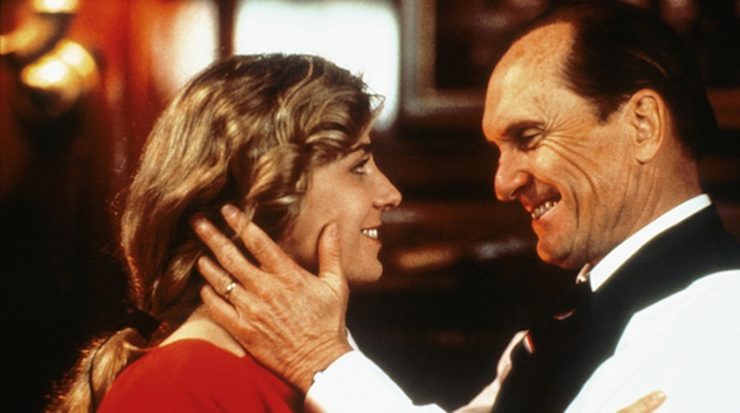
If anything, Serena and Offred become sexual comrades, or confidantes; Serena plays a madame of sorts when she arranges for Nick to impregnate Offred (which, as previously established, helps all the women of the household while keeping the man’s ego intact). But while Offred and Nick are having forbidden sex in his apartment, Serena does not return to her bedroom to distract the Commander from calling upon his Handmaid for late-night Scrabble. Instead, she stays up and watches old footage of herself singing “Amazing Grace” in her former life, conducting her younger self with her cigarette, her face rapt with nostalgia for past freedoms.
The sympathy for Serena Joy is less puzzling, as the Aunts instruct the Handmaids to “think of the Wives” and how hard all of this is for them, to accept an interloper and quasi-rival into the homes they’ve made. But the Commander seems to earn the same measured consideration, despite his part in the galling proceedings that created Gilead. After Offred murders him, we are treated to a final tribute to his military prowess in patriotic warfront footage; it’s broadcast by the Eyes, pure propaganda.
And there is the biggest shocker of the film, the radically different ending. Someone affiliated with Ofglen and the Mayday resistance smuggles in a switchblade and a note—which is shocking for its content but not the fact that it’s the first written word Offred has seen in years—that something will happen at 10 p.m. tomorrow. Offred seems to disregard the note, but keeps the knife, as the next day is when Serena Joy catches her redhanded (or black-boa’ed?) sneaking out to Jezebel’s.
Instead of retreating to her room like a punished child, Offred visits the Commander’s office one last time, to beg him to intercede on her behalf. It’s a bizarre scene: She stumbles in on him holding a loaded gun, his nerves frayed despite the footage we’ve just seen of him calling the war “a comparably stable situation” and promising “a breakthrough for our forces.” To her desperate plea, he simply shrugs helplessly, every part the henpecked husband: “What could I do? She gave me hell, she gave me all kinds of grief.” Wives, amirite? he asks of his concubine, even now looking for sympathy.
You can hardly blame Offred for ramming the knife in his neck. The way that the Commander grabs at her, so that they go down together, drenched in his blood, is eerily reminiscent of his violent kiss, the one he expected as a reward for Scrabble and Cosmo, earlier in the film.
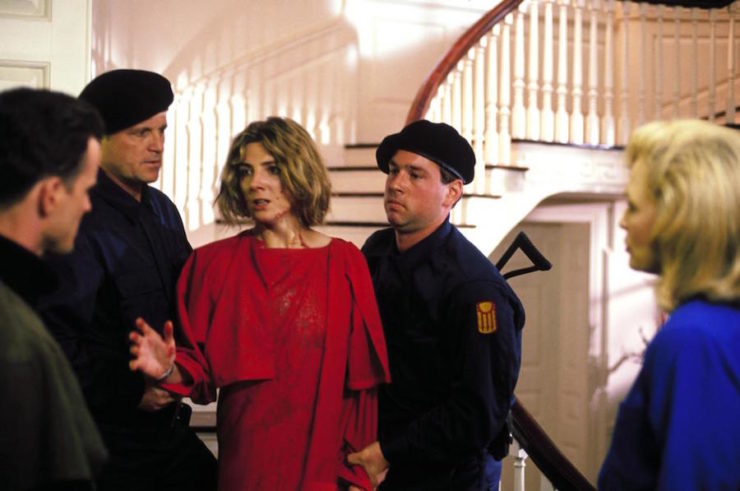
And so, when the Eyes come for her despite Serena Joy not calling them, it’s under the pretense of arresting her for murder. But instead of Offred stepping into a black van and emerging centuries later as a voice on a cassette tape at a Symposium, we stay with her—in linear time, yet again—except now she’s Kate, and she’s pregnant with Nick’s baby, hiding out in an old trailer in the wilderness. She waits for news, but she has hope that she will be reunited with her daughter Jill and that she and Nick will bring their unborn child into a new world.
Of course she has hope. She’s only been a Handmaid for a few months! The whole experience—and the same could be said for the movie—passes as if it were a bad dream.

Back in the 1980s, Atwood decided against adapting her own novel for the screen due to timing conflicts, and though she consulted on specific details, she was emphatic that the screenplay was in no way hers. The result, though sanctioned, was clearly The Handmaid’s Tale as seen through the eyes of two men: equal parts violent and erotic sex performed upon a Handmaid who tells us no more than whatever neutral remarks she utters aloud.
For the upcoming TV adaptation, Atwood is not just a consultant, but a consulting producer, this time with a creative team that seems to be almost equally male and female. While executive producers Bruce Miller and Warren Littlefield have earned acclaim for their work on (respectively) The 100 and Fargo, star Elisabeth Moss also serves as producer, and executive producer Reed Morano (who also directed the pilot) has been more vocal than anyone in promoting the series on Twitter and Instagram. The Republic of Gilead may have been created by men, but The Handmaid’s Tale requires female voices.
But no voice is as vital as Offred’s. Rather than shy away from the device, the TV series’ writers have turned Offred’s internal monologue almost into its own character, distinctive from her demure Handmaid persona. She’s Joe establishing the boundaries of his futuristic world in Looper, the Narrator enumerating his vendettas in Fight Club, Leonard constantly filling in his empty memories in Memento, Joel’s voice detailing the relationship that lived and died but deserves a second chance in Eternal Sunshine of the Spotless Mind. And even though I already know how it ends, I can’t wait to hear the rest of her story.
Natalie Zutter burst out laughing in the first five minutes of The Handmaid’s Tale movie, and the rest of it was downhill from there. Follow her on Twitter and Tumblr.











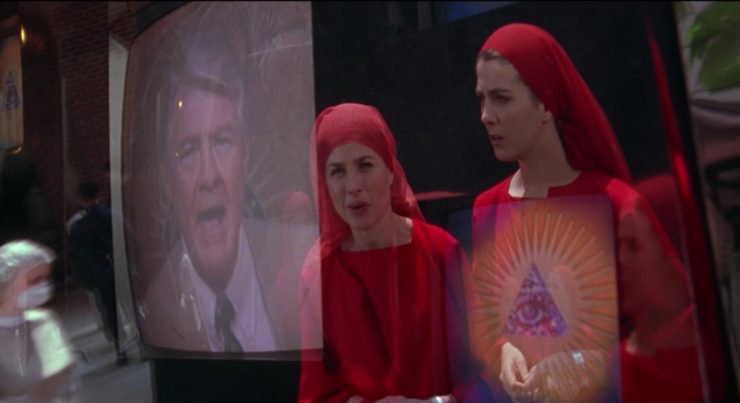
I almost want to see this just to see how bad it is. But it also seems kind of typical to strip out internal monologue in the name of filmmaking, especially for a movie (although I love the examples you bring up which show it can be done well). But you are right that Offred’s voice really is the key voice here and it’s a shame she gets silenced, yet again.
Heh. My mother, who’s a great Atwood fan, once told me how the advertising firm she worked for actually had a hand in promoting the movie for the Toronto area and how dismayed she was at how bad she found it to be. Especially considering it had people of the caliber of Pinter, Dunaway and Duvall involved. She didn’t really elaborate on how bad it was, so good to know.
Also, I only finished to read the book recently, so I avoided your reread for spoilers, but went back afterwards, and reading your thoughts and musings made an already rich experience, richer. Thanks!
I remember a relatively good movie when it came out…It feels like either the internet is trying to rewrite history (which is a phenomenon I’ve seen too often recently regarding pop culture). Or I just don’t know what the hell I’m talking about, which could be equally true.
… or perhaps the internet is allowing us to compare it to the source material that the movie seems to have butchered.
I saw this as a teen (after reading the book). It seemed oddly flat to me, despite some striking visuals making good use of the women’s costumes and colour-coding (and the changed ending was rather more cathartic, if less original), but at the time I couldn’t pinpoint why. I did notice that it compressed the time scope a lot by making Offred a raw recruit, and having Offred present at Moira’s jailbreak was just plain bad writing (even if for some reason it weren’t possible for them to escape together, shouldn’t the film have addressed this? Instead we come away with a scene that looks like Moira ditching her friend in a life of slavery, while Offred is too passive to care.)
Thank you for this analysis. I think
I saw this movie when it opened (I had already read the book) and hated it. I realized it wasn’t the book early on and tried to enjoy it as a movie but…it never really worked. I agree that Faye’s performance was good and the only thing I now remember. Those eyes of pain and self hatred. It is a wonderful performance by a great actress in a very poor movie. And I am sorry to say it was not well accepted at the time by critics or movie goers. I am glad that this new version looks much more the story as it should be told.
“A movie about a threesome gone wrong”…
*headdesk*
As always, you are welcome to disagree with the opinions and interpretations expressed in the article above, but we ask that you consult our commenting guidelines and avoid making personal attacks on the writer of the piece or other commenters or making hurtful or disparaging comments. You are welcome to address differences in opinion in a civil and constructive way.